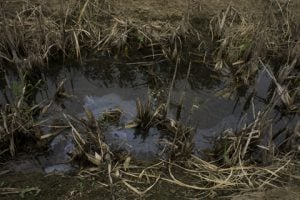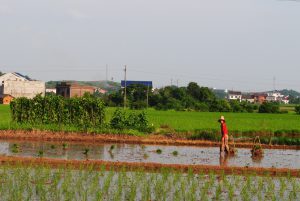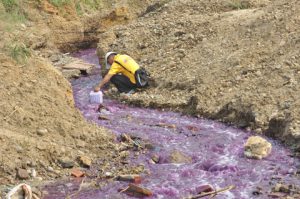After nine years of debate, a draft of a plan to improve China’s standards for controlling land pollution was released by the Ministry of Environmental Protection in mid-January. The standards, which have been released so the public can comment, would add more chemicals to the list of those monitored and put stricter requirement on pollutant levels, especially for farmland.
Land pollution has become one of the public’s top concerns, but plans to update national soil quality standards have run into obstacles. The current standards base the maximum levels of major kinds of pollutants on the land’s designated purpose and include a mechanism for monitoring pollution.
Environmental experts have long complained that the standards, which took effect in 1996, are outdated. A land pollution survey, released in April 2014 after eight years work, indicated that 16.1 percent of the country’s land contains excessive levels of pollutants. Nearly one-fifth of tested farmland was found to be heavily polluted.
Calls for stricter standards have risen, but several environmental experts said that despite the fact a draft has been published, government agencies and academics are still debating details and no timetable has been set for the new standards to take effect.
A different approach
Over the past several years, Chinese environmental experts have established updated national standards for water and air quality as the pollution situation worsens.
But work on drafting standards for land pollution – which is much more difficult to detect – has been slow, even though the national survey indicated the country’s land is tainted by alarming levels of pollution, mainly from cadmium, arsenic, chrome, lead and other heavy metals emitted by industries.
Experts say there is little to learn from other countries when drafting the national land standards. Chen Tongbin, an environmental expert at the Chinese Academy of Sciences, said Western countries generally have less pollution issues regarding farmland, and thus have no need to set a specific national standard for soil quality.
Land in Western countries is normally privately owned, and the owners aim to protect their property from pollution, Chen said. But in China where “one-fifth of farmland is found with excessive levels of heavy metal pollutants, there must be a standard for pollution control and the land pollution issue must be linked with food safety,” he said.
Internationally, risk evaluations are more frequently used as a land pollution control mechanism. Whenever indicators for major pollutants exceed benchmark levels, a detailed evaluation will be conducted to study the situation and launch measures to fix the problem.
In the US, the government established soil screening guidance as a framework for evaluation. This is accompanied by a specific range for contamination limits issued by each state. In most other countries, soil quality is part of a complicated pollution evaluation system.
China is taking a different approach, working on a set of unified standards for pollution levels. “Almost no major country has set a unified national standard,” said Chen.
In the United States and Europe, land pollution controls are mainly for land used for industry because pollution of farmland in these countries is not as serious as in China.
New revisions
An introduction to the document listing the proposed new standards says the changes are intended to address “the new challenges and problems in China’s soil situation.”
The new version evolved from 1997 standards on soil quality into standards for farmland, and adds a separate section for land designated for construction.
The 1996 national standards list only 10 categories of contaminations. The new version adds more than 10 new categories, such as manganese and cobalt. Wang Guoqing, a researcher at the environmental ministry’s Nanjing Institute of Environmental Sciences who participated in the drafting of the new standards, said the new items were added because these pollutants have been found in high levels in parts of the country in recent years.
The revision also lowers the limits for major pollutants in soil. In the original version, the level of lead was required to be between 250 and 350 milligrams per kilogram of farmland soil. The new standard cuts the level to less than 80 milligrams.
The change was made to get to grips with worsening lead pollution, which has been proven to be very harmful to people’s health when absorbed into the blood, Wang said. This is especially true for children’s intellectual levels and growth.
In the face of the rising concerns about cadmium, the new standard sets more specific requirements for acceptably levels of the carcinogenic heavy metal under different conditions.
The proposal also include improvements in pollution-monitoring requirements, asking local authorities to take measures to prevent pollutant levels from rising, rather than simply meeting a standard. Wang said such requirements reflect the central government’s desire to improve the soil quality of farmland in order to better ensure the safety of agricultural products.
But some experts say the proposed changes are too rigid. The most criticized is the idea to keep a previous model for unified limits on pollutants, rather than considering specific local conditions.
Implementation
Song Yun, chief engineer of the Environmental Protection Research Institute of Light Industry, said that “soil standards should be linked with local soil conditions.” In some regions, the overall levels of heavy metals in the soil are higher than other places, making the standards hard to implement.
“The most important thing about standards is implementation,” said Yang Linsheng, a researcher at the Institute of Geographic Sciences and Natural Resources Research under the Chinese Academy of Sciences (CAS). Some standards set in the draft will face difficulties in practice, including those for lead and cadmium, Yang said.
Zhao Xiaojun, a researcher at China National Environmental Monitoring Center, wrote in an essay in Environmental Sciences, a CAS journal, that the 1996 standards put too much emphasis on unified limits, lacking consideration of the diverse soil conditions across the nation. “Using a unified standard to evaluate land in different regions is not scientific,” Zhao wrote.
For instance, China has 20 main types of soil that contain very different levels of cadmium, making it difficult to judge the pollution level of the metal under one standard, Zhao said. He suggested a ladder design for standards to be applied in different regions.
However, most of the pollution standards in the proposal set unified limits. “For the public, the stricter a standard looks, the better,” Chen said. “But in management, if the standards are too strict to be implemented, the effects won’t be good.”
In the days after the draft was released, the environmental ministry received a lot of feedback, Wang said. A second round of revisions will be conducted to take these opinions into account.
Yang said issuing new standard is only a start. The biggest challenge is implementation by the central and local levels of governments. “There should be an interpretation of the standards for local governments to implement, just like laws have judicial interpretations,” he said.
Wang said law should be written to support the standards. China has no law regarding the protection of soil, and also needs a way to supervise the monitoring of soil.
This article appeared originally on caixin.com (Rewritten by Han Wei, Caixin)







